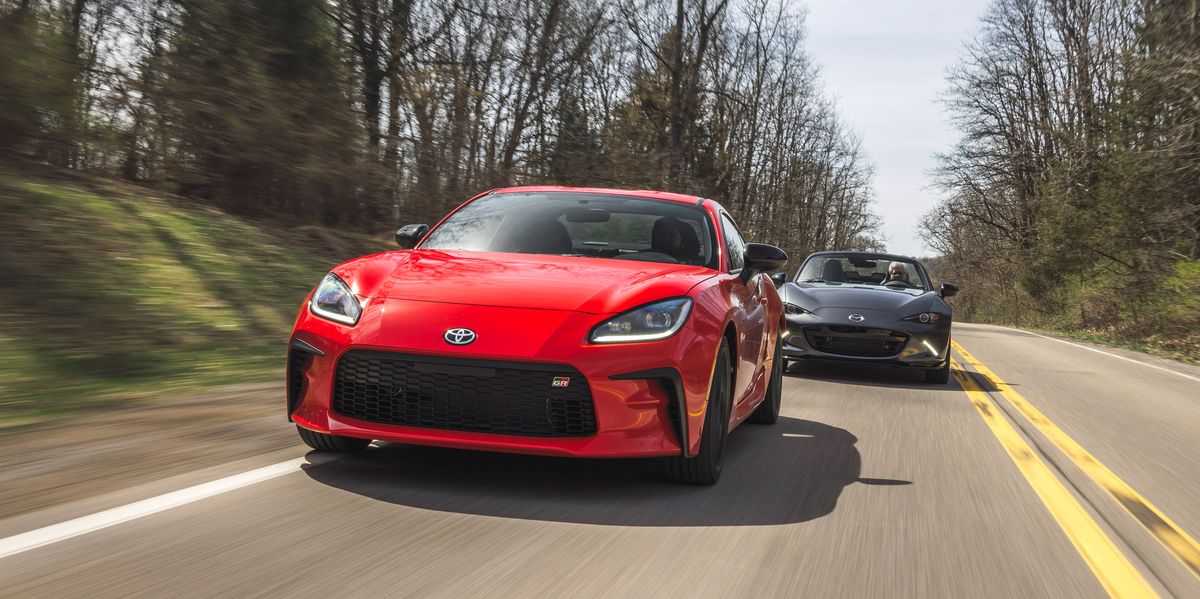Tested: 2022 Toyota GR86 Premium vs. 2022 Mazda MX-5 Miata Club

From the July/August 2022 issue of Car and Driver.
If the Mazda MX-5 Miata and the Toyota GR86 were on the show Finding Your Roots, both would trace their ancestry back to wispy midcentury European roadsters. Over the decades, many of those Old World sports cars died out or evolved into bigger and more complex things, leaving only Mazda and Toyota (and Subaru, maker of the GR86’s twin, the BRZ) building basic, pared-down, inexpensive sports cars that deliver old-school fun.
If that’s what you’re after, your search starts and ends here. The GR86—substitute the BRZ if you prefer Subarus—and the Miata are the only remaining descendants on the affordable branch of the rear-wheel-drive sports-car family tree. Each is a hoot to drive, but which one is the better starter sports car?
Michael SimariCar and Driver
To find out, we corralled the most aggressive and exciting versions of those two models: the GR86 Premium and an MX-5 Miata Club convertible. Their standard equipment is similar—small, high-revving naturally aspirated four-cylinder engine; six-speed manual transmission; summer tires. Both are rear-wheel drive, like the sports cars of old. In search of purity, for this comparison test, we selected the Miata softtop over the retractable-hardtop RF model.
These sportsters’ base prices are about as close as their spec sheets: $31,325 for the GR86 Premium and $32,165 for the Miata Club. Our Mazda’s price ballooned to $37,260 thanks to Machine Gray paint and the $4500 BBS Recaro package, which includes Brembo front brakes, Recaro buckets, and BBS forged wheels. The GR86 had special Track bRed paint ($425) and a few accessories that brought it to $32,432, a significant $4828 less than the Mazda.
Michael SimariCar and Driver
2nd Place:
Mazda Miata
Highs: Eager engine, playful chassis, often requires SPF 30.
Lows: Wobbly in hard cornering, pricey BBS Recaro package, who hid the glovebox?
1st Place:
Toyota GR86
Highs: Easily exploitable handling, plenty of zip, surprising practicality.
Lows: That grinding sound is the engine, clunky-looking dash, the only thing noisier is a Miata.
Michael SimariCar and Driver
Traditionally, starter sports cars have been more about playfulness than all-out performance. This pair updates that notion with solid test numbers. Both reached 60 mph in 5.4 seconds. The Miata completed the quarter-mile sprint in 14.2 seconds at 97 mph; the GR86 did it in 14.0 seconds at 101 mph. Their cornering grip is close, too, with the Miata circulating the skidpad at 0.95 g and the GR86 sticking to it at 0.97 g. Their 70-mph stopping distances are within five feet of each other.
Beyond our instrumented tests, we put these two agile runabouts on an autocross course since we expect some owners will too. The course, on the beautiful M1 Concourse campus in Pontiac, Michigan, was soaked with rain, enabling our rear-drive charges to slide their tails like they were powered by NASCAR V-8s. The GR86 was easier and more fun to slip-slide through the cones, though its best run of 26.7 seconds was only a little quicker than the Miata’s 27.1-second time.
Michael SimariCar and Driver
Michael SimariCar and Driver
In everyday use, both cars live up to their mission of joyful driver involvement. They’re especially nimble, with crisp, well-weighted steering that cuts precisely and offers reassuring effort buildup. Swapping gears takes only fingertip flicks of their shifters. Their engines are eager to rev. Their clutches are light, and their brakes bite with authority. Both ride firmly, tautly damping out pavement heaves and clip-clopping over seams. If only they sounded sexier—the Miata emits an undistinguished hum; the GR86 howls at high rpm like a blender set on puree.
Press them hard, though, as we did on our squirrelly 10Best evaluation loop, and the GR86 shines while the Miata fades. With stellar chassis tuning, the Toyota feels planted and secure, like it will never get away from you. In hard corners the Mazda lists like a drunk with an elbow on the bar and leans on its rear tires in an antsy two-step, threatening to snap sideways. Rough pavement sends shivers through the open structure. Push vigorously and the GR86 proves it’s the more gifted athlete.
Michael SimariCar and Driver
Neither car is a great long-distance companion due to wind roar at highway speeds. Going 70 mph, the GR86 whooshes along with a noisy 74 decibels inside, and the Mazda’s top-up 79-decibel cacophony sounds like you’re parked next to an idling 737. At 80 mph, turning on either car’s audio system isn’t worth it.
Of course, comfort has never been a priority for starter sports cars. And yet, these vehicles are far from bare-bones, with standard heated seats and decent infotainment. But their daily usability and convenience diverged enough to influence the outcome of this comparison.
Michael SimariCar and Driver
Michael SimariCar and Driver
The Miata’s cabin has so little space that stowing a pair of sunglasses is a hassle; the only available spot is a shoulder-height storage box between the seats that requires contortionist skills to access while driving. Its cupholders are all but useless. There are no map pockets. The GR86, meanwhile, offers a glovebox, multiple storage cubbies, and that vestigial rear seat, a convenient landing zone for gym bags or groceries. The Toyota feels like a real car rather than a limited-use weekend toy.
Both cars carry on the fun-to-drive tradition of their ancestors. But one offers better performance, more poise under pressure, a more accessible price, and far superior practicality. While the GR86 means you give up open-air driving, it delivers more and asks you to sacrifice less. It is the starter sports car to have.
A car-lover’s community for ultimate access & unrivaled experiences. JOIN NOW
This content is created and maintained by a third party, and imported onto this page to help users provide their email addresses. You may be able to find more information about this and similar content at piano.io




